By Judy Gonyeau, managing editor

Grand Ole Opry
promotional flyer.
From about 1920 to 1945, radio developed into the first electronic mass medium, monopolizing “the airwaves” and contributing to the defining of mass culture for an entire generation. On November 28, 1925, country music stepped up to the microphone.
Back to the Beginning
The Grand Ole Opry started life on a brand-new radio station located in Nashville with the call letters WSM-AM. On that last Saturday of November “Barn Dance” traveled over the airwaves hosted by George D. Hay from a 5th-floor studio in the National Life & Accident Insurance Company. From the very first show, the mission was to honor all forms of country music and its history. Bluegrass, folk, and gospel, along with comedic performances and skits brought people together around a radio for a night’s entertainment. (Back in 1925, only about 19% of households had radios!)
On December 10, 1927, a name change occurred and the phrase “The Grand Ole Opry” was born. It was a play on words, given that the show followed NBC’s network’s “Music Appreciation Hour” where the music was often from the Grand Opera. The show titled “Barndance” lived on in a new show called the “National Barn Dance.”
Fans! Fans! Fans!
The Grand Ole Opry was also viewed live by fans who had tickets to get into the show’s offices. That, however, quickly became too small for the many seeking to see the show live.
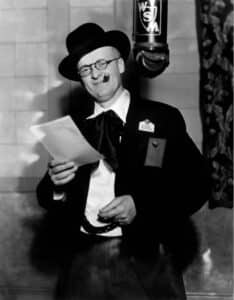
In October 1934, the Opry moved into the then-suburban Hillsboro Theatre (now the Belcourt) before moving to the Dixie Tabernacle in East Nashville on June 13, 1936. The Opry then moved to the War Memorial Auditorium, a downtown venue adjacent to the State Capitol, and a 25-cent admission fee was charged to try to curb the large crowds, but to no avail.
Later, in June of 1943, the Opry moved to the Ryman Auditorium. Shows continued to be broadcast from the Ryman until March 15, 1974, when the Opry moved to its brand-new venue after National Life & Accident bought farmland owned by a local sausage manufacturer along the newly finished Briley Parkway. This venue was hailed as the centerpiece of a larger entertainment complex that later included the Opryland theme park and hotel. This venue holds 4,000 people, has air conditioning, and features a built-in space for television production of the Opry shows and other music specials aired on NBC and later, CBS. A large circle of wood from the center of the Ryman Auditorium’s now-famous stage was cut from the floor and placed center stage at the Opry’s new location. It opened on March 16, 1974, with President Nixon as one of the performers.
The End of the Ryman?
Ryman Auditorium was originally built as a church called the Union Gospel Tabernacle in 1892. The building was renamed Ryman Auditorium in 1904 after Tom Ryman, the sea captain whose idea it was to build the church, passed away. Among the most striking features of the Ryman are the original oak pews. The pews on the main floor are the original from 1895 and the balcony pews date back to 1897.
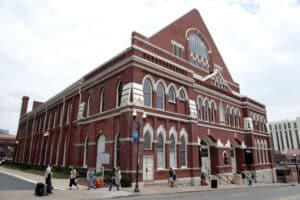
Although the Ryman was deserted for about 20 years following the opening of the Opry’s new venue, it went through a total renovation in 1993 and reopened with a broadcast of A Prairie Home Companion on June 4, 1994.
The Opry was also performed at the Ryman when construction or other necessary closures affected its new home. But the Ryman came roaring back for the Opry after a flood that caused the Cumberland River to overflow its banks in 2010, hosting many of the Opry shows as repairs were made, including the restoration of the Ryman “circle” on the Opry’s stage. The Grand Ole Opry never missed a beat.
Membership
The Grand Ole Opry is often referred to as a “family.” Its inductees are carefully selected and with that membership comes privileges and obligations. According to www.opry.com, “Opry membership requires a passion for country music’s fans, a connection to the music’s history, and it requires commitment – even a willingness to make significant sacrifices to uphold that commitment.”
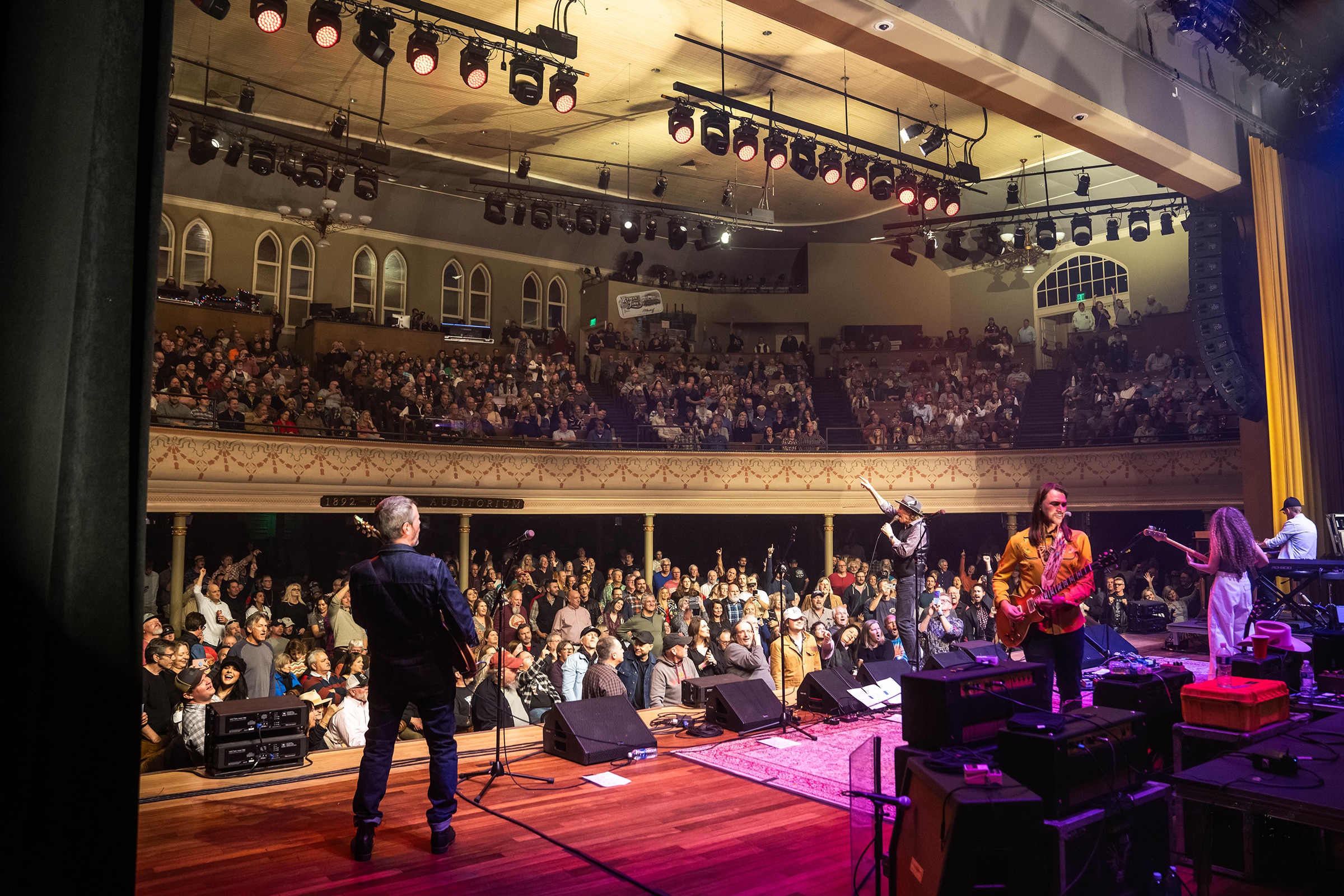
The selection process is handled by the Opry’s management team. While radio airplay, sales, and touring all factor in the decision to take in a new member, the team also looks to add in performers who keep the Opry’s cast balanced as it applies to a performer’s musical prowess and generational appeal. Often, members nominate others to join the family. “But, really, it comes down to just one word: relationships. The relationships between performers and fans.
The relationships Opry members have with each other – relationships that may last for decades. And, perhaps most importantly, the relationship between each artist and the ideal of the Grand Ole Opry.”
What About Elvis?
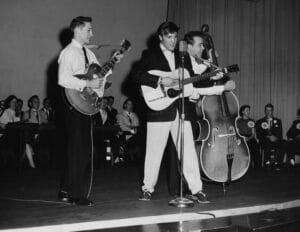
Opry memberships do not expire until a member passes away. But, have some stars been turned away or stripped of their membership? Yes, and yes. Even Elvis.
In 1954 when Elvis was 19 years old, his manager Sam Phillips (of Sun Records) had just released That’s All Right which was starting to get some traction locally but wasn’t well-known outside Memphis. So, Phillips decided to try to get Elvis on the Grand Ole Opry. Phillips connected with the Ryman’s General Manager, Jim Denny, who agreed to let Elvis appear but refused to let Elvis perform That’s All Right, only letting Elvis sing his version of the Bill Monroe song Blue Moon of Kentucky.
Host Hank Snow forgot Elvis’ name and introduced him as, “A young man from Memphis.” Elvis proceeded to belt out Blue Moon of Kentucky. His high-energy version of the bluegrass hit wasn’t quite what the Opry audience was used to hearing.
Stories circulated for years that Elvis “bombed,” but stories do vary depending on who you ask. Apparently, Denny said Elvis should “go back to driving a truck.” Elvis never stepped onto the Opry stage again.” … except once when he went back to the Ryman a few years later to visit backstage with Johnny Cash and other performers and friends.
Once a Member, Always a Member?
Opry members must appear regularly on the Grand Ole Opry, with at least 10 performances per year. They pay dues, but the benefits for each artist are innumerable. At each show, there are typically 5-7 members performing, and members can choose whenever they want to play.Putting your name next to “Grand Ole Opry” was a boon by itself. But, at times, those Honky Tonk Blues took their toll on some members who were let go from the Opry.
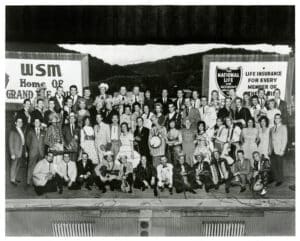
Ryman Auditorium in Nashville, Tennessee.
According to Rolling Stone, “On August 15, 1952, it was announced that Hank Williams had been released from his contract with WSM and the Opry after failing to show up for any Opry performance a week earlier and another promotional event the following day. Williams’ crippling drug and alcohol addiction would lead to his death at age 29, just four months later.”
Other stars that were removed from Opry membership (and some were brought back in) include Johnny Cash (after he smashed stage lights with a microphone stand where alcohol played a role, but he was reinstated later), Jerry Lee Lewis (Jerry Lee Lewis’ 1973 Grand Ole Opry debut broke several rules, but perhaps most critically, he dropped an F-bomb from the stage and among other offenses, blew through his time limit on stage and did not stick to country music), and even the incredibly popular Minnie Pearl! (who was given a one-year leave because she did not perform enough to maintain membership).
Who Else? For country music (and just plain ol’ good music) fans, here are a few names of performers who are not currently members: George Strait, Kenny Chesney, Willie Nelson, Brooks & Dunn, The Chicks (aka The Dixie Chicks), Faith Hill and husband Tim McGraw, Miranda Lambert, Luke Bryan, Zac Brown Band, and the group Alabama. Just because they are not members does not mean they never perform with the Opry, but they play as guests.
Transitions
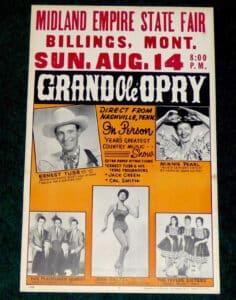
Over the years, the Grand Ole Opry has gone through many growing pains and challenges to maintain its mission of honoring country music and its history – especially when it came to making changes as music changed. Mini skirts? Crazy hair? The general lifestyle of the 1960s were not considered proper for the Opry. Those “long-hair hippies” of the 1970s and their “drug-induced states” were considered a big “No” at the Opry. When the Byrds were invited to perform, cat calls included “Cut your hair!” and “Tweet Tweet” from a somewhat hostile audience. Rock and Roll? C’mon, now.
Over time, the Opry succumbed to the “fall of the gingham curtain,” bringing a new wave of country music style that showed up on its stage. Welcome to the 1980s and to the Opry show, Garth Brooks, Randy Travis, Merle Haggard, Keith Whitley, Bonnie Raitt, Reba McEntire, Vince Gill, Travis Tritt, and Dolly. A streak of new performers brought country music back into the homes of millions of new fans right up through today. Rock ‘n’ Roll? Let’s just share that the Ryman is designated as a Rock & Roll Hall of Fame landmark.
Another bone of contention was what instruments were permitted on stage – drums, in particular. Traditionally, a string bass provided the rhythm component in country music, and percussion instruments were seldom used. Electric amplification, new in the beginning days of the Opry, was regarded as the province of popular music and jazz in the 1940s. Although the Opry allowed electric guitars and steel guitars by World War II, the restrictions against drums and horns continued until 1967 when Billboard wrote “[a] full set of drums was used on the ‘Grand Ole Opry’ .for the first time in history when Jerry Reed performed last week. Jerry’s drummer, Willie Akerman, was allowed to use the entire set during his guest performance there.”
Collecting the Opry
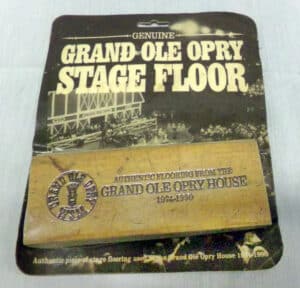
House stage from 1974-1990
When it comes to memorabilia, most collectors look for items connected to their favorite Country singer rather than Country music. When that singer is a member of the Grand Ole Opry, it tends to be all about the shows they’ve played. Show posters were immensely popular – and can be quite rare. Most were nailed to barn doors, taped into business windows, or ripped up after a show took place.
Finding vintage posters and flyers in good shape can be a challenge, depending upon who was starring on the show. Reprints are in good supply, but an original 1965 Opry poster for a traveling show featuring Ernest Tubb and Minnie Pearl going to Billings, Montana can set you back $595. An original 14” Little Jimmy Dickens Grand Ole Opry boxing-style poster from when he and Jack Roberts, among others, played the Playquata Ballroom in Washington State currently commands $1,250 online. Elvis Costello played the Opry in 1982 and you can pick up that performance’s poster for $60.
You can buy a piece of the Ryman stage dating from 1951 through 2012 in a frame for $1,600 at www.opry.com, or pick up a piece of the stage from Opryland that dates from 1974-1990 (well before the flood) for $89.99 at eBay.
Autographs can also command a wide array of prices. One example is a Grand Ole Opry-signed autograph book signed by Hank Williams at his 1949 Opry debut (just six months before he died of alcohol-induced heart failure) that sold for $1,948 at RR Auction in Amherst, NH. Other signers in the book include Minnie Pearl, Roy Acuff, Bill Monroe, and Tex Ritter. Another Hank Williams autograph found on a Grand Ole Opry program sold at Heritage Auctions for $1,625.
Items worn or played onstage are sought out by serious collectors. A dress worn onstage by June Carter Cash sold in 2005 for just $300 at auction. A sunburst Gibson Banner SJ from circa 1945 once owned by the country music pioneer Hank Williams sold at Heritage Auctions in 2021 for $15,000. A Martin HDO Grand Ole Opry 75th Anniversary Limited Edition guitar will set you back around $3,800-$4,900 and, while it may have never seen the Opry stage, it is hailed as having a huge sound that plays great.
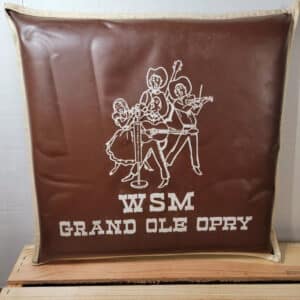
seat cushion selling on eBay for $40.
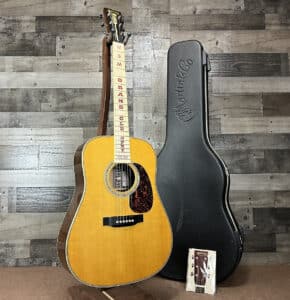
Other collectibles include everything from salt and pepper shakers to refrigerator magnets galore. There is a Grand Ole Opry Barbie. Souvenirs including postcards, ticket stubs, clothing, programs, drink cups, toy guitars, plates, bottle openers, key chains, music, signed photos, and vintage t-shirts are for sale across the internet and can be found at vintage shows and markets.
It is the experience of the Grand Ole Opry that makes any of these items valuable to collectors. Making that connection to America’s Country Music family is worth the investment and the trip to Nashville when you get the chance.
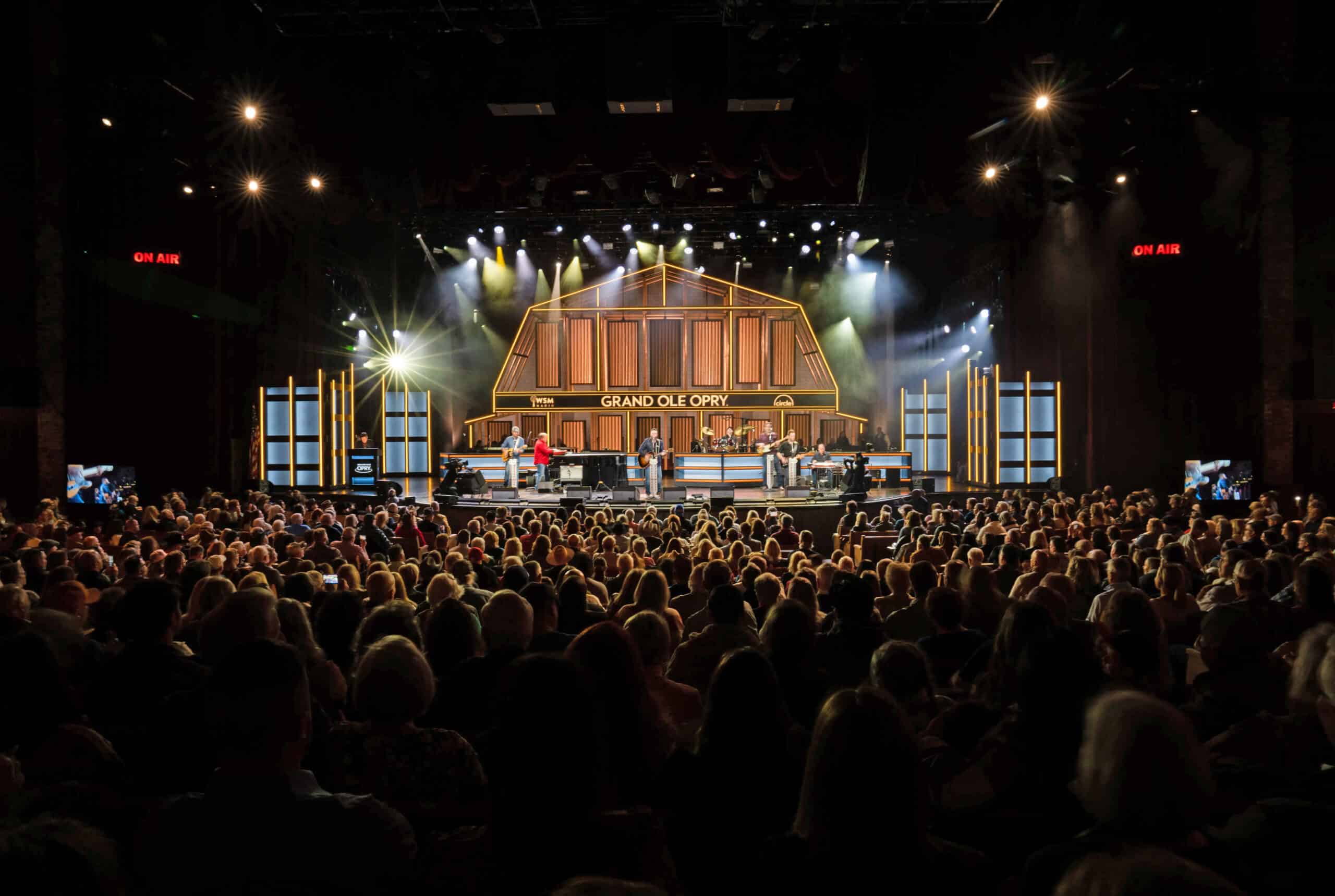





Related posts: